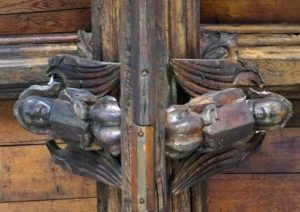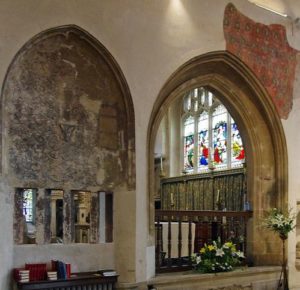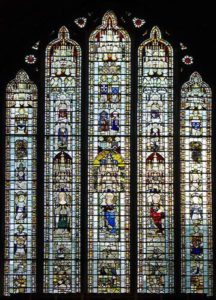This is the largest church in Gloucestershire and was built in the C15/16th on the site of an earlier church, using money from wool. The church was the joint work of the town and nearby St Mary’s Abbey. There were ten wealthy wool merchants in mid 14th-century Cirencester and the abbey had extensive flocks of sheep. The coats of arms in the nave are mainly those of nobles and of the abbey.
It is a big church and it is almost impossible to photograph, let alone take in its size as it is screened by surrounding buildings. It is a marvellous example of perpendicular architecture with large windows ad crocketed pinnacles. The tall square west tower with its blind arcade of arches, dominates the Market Place. The Guilds paid for a spire, but this was never built as the walls of the tower were thought to be too weak.
The huge three storey south porch was built by the Abbey in 1490, who used the ground floor. The guilds used the first and second floors. After the dissolution of the monasteries and Reformation, the porch served as the town hall. It was originally separate from the church and only joined to it by a corridor with fan vaulted ceiling in the C18th. It has been recently cleaned and the stonework gleams golden against the rest of the building. Today it is used for choir practice, music groups and children's activities.
Steps lead down into the church. This is massive in size and the tall slender pillars with pointed arches separating nave and side aisles accentuate the height. At the tops of the pillars are painted carved angels holding shields. Above are clerestory windows above blind arcading. The wood beam roof has small carved bosses.
By the south door is the C14th octagonal font with damaged carvings around the bowl, probably done during the Reformation when it was removed from the church. It was discovered in the abbey grounds in the C19th and returned to the church.
The wine glass pulpit dates from 1440 and probably survived the Reformation as it has no religious imagery. It is beautiful open carved stonework, still brightly painted.
At the back of the south aisle is the Mannox tomb, a splendid structure with black marble pillars supporting a portico with coat of arms, helm and reclining figures. Below are the kneeling figures of George d1638 and his wife holding hands. Below are the kneeling figures of their two daughters.
Above the pointed chancel arch is a Cotswold Window with stained glass. Below is a rood screen with open carved base panels and a canopy across the top. Above, hanging from the chancel arch is a cross. The chancel was begun in the C12th and is the oldest part of the church. The wood roof above the sanctuary is painted. Behind the altar is a splendid reredos with Christ Crucified in the centre surrounded by angels.
On either side of the chancel and off the side aisles are chantry chapels.
At the end of the south aisle is the Garstang Chapel, a small chapel surrounded by a C15th wooden parclose screen. This has a small altar. In a wall niche with two painted shields at the top is a carved wooden box with more shields on the front. Beyond it was the Chapel of St John the Baptist, but this now contains the organ.
Behind glass in small recess at the end of south aisle is the silver gilt Anne Boleyn Cup. This was made for Anne and given to her daughter Elizabeth. After she became queen, she have it to her physician, Richard Master. He presented it to the church in 1561. Below it is a C15th strong chest.
On the north side of the chancel are two chantry chapels. Nearest is St Catherine’s Chapel with its beautiful fan vaulted ceiling. This was installed later and may have come from the abbey after the dissolution. There are remains of wall paintings. The altar front is embroidered with an image of St Catherine. The Baroque reredos has the crucifixion in the centre with the Virgin Mary, St John and other figures.
Beyond it is the Lady Chapel with the splendid early C17th tomb of wealthy lawyer Humphrey Bridges and his wife, set under a massive arch with their recumbent bodies with heads resting on red tasseled pillows. There are large kneeling figures of their two sons at their head and feet and nine smaller daughters along the base. On the opposite wall is the tomb of Thomas Masters, a late C17th gentleman elegantly propped up on one arm.
On the wall between the two chapels is the Royal Coat of Arms.
The Trinity Chapel off the north aisle has and elegant base screen of open carved stone. The stone reredos has a carving of Christ in Majesty in the centre. This was founded by Richard Dixton and William Prelatte, both knights under Richard, Duke of York. A priest from the neighbouring abbey said masses for the souls of the kings and queens of England.
This is a large and splendid church and is often called the Cathedral of the Cotswolds. It is open daily. There is no parking by the church, although there are plenty of car parks around the centre of the town.










